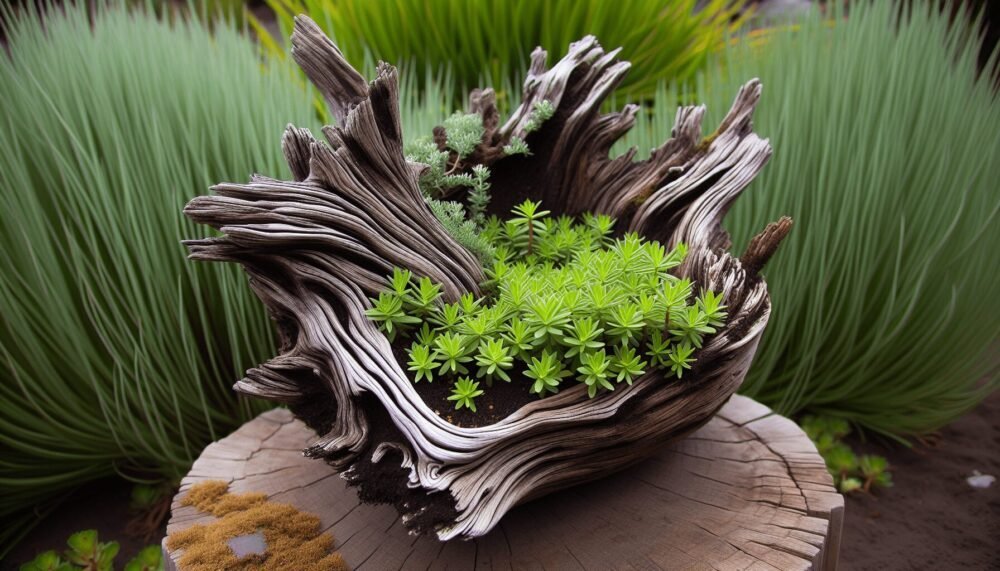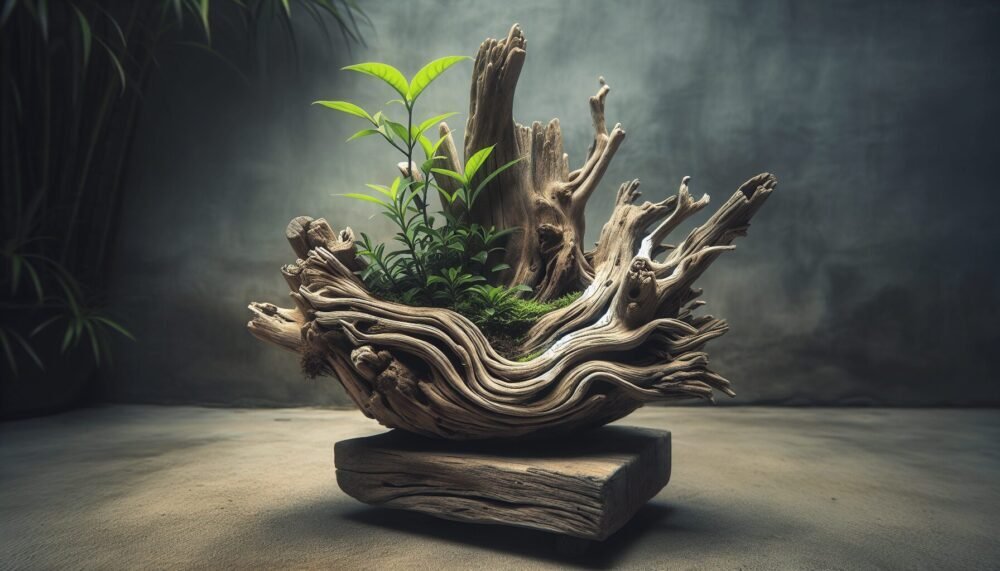Have you ever thought about combining your love for plants with a touch of natural artistry? Driftwood planters might be just the twist you need to add a unique, rustic charm to your green spaces. This natural decor not only appeals to nature lovers but also fits into various interior design styles, from bohemian to coastal themes.

What Is Driftwood?
Driftwood refers to wood that has been washed onto a shore, often enriched by long exposure to the mineral-laden waters and weathering effects of the environments. It embodies a rugged, worn beauty that tells its own story. As it drifts to the shore, it often picks up interesting shapes and textures, making each piece unique.
How Driftwood Forms
Driftwood starts its journey as regular wood from trees. It enters bodies of water through natural processes like falling during a storm, or human activities such as logging. Once in the water, the wood gets weathered and smoothed by natural forces. Salt, sun, wind, and currents work in tandem to create the varied and fascinating textures you’ll find.
Types of Driftwood
While exploring driftwood planters, you may come across driftwood of different woods like pine, cypress, and cedar. Each type offers different characteristics, which may influence your choice depending on the aesthetics and durability you’re after.
| Type of Wood | Characteristics |
|---|---|
| Pine | Light color, soft |
| Cypress | Decay-resistant, cool tones |
| Cedar | Aromatic, rich color variations |
Why Choose Driftwood Planters?
Integrating driftwood into your indoor or outdoor garden space has several benefits. From environmental friendliness to aesthetic appeal, there’s a lot to appreciate in these natural creations.
Environmental Benefits
By opting for driftwood planters, you’re making an eco-friendly choice. Driftwood planters utilize wood that has already fallen, thereby minimizing the need for new timber and promoting the repurposing of natural materials. Additionally, driftwood is biodegradable, making it a sustainable option.
Aesthetic Appeal
The rustic and weathered appearance of driftwood creates a unique, artistic look that can complement any setting. Whether you’re aiming for a coastal vibe or an earthy atmosphere, driftwood planters add a touch of nature that is hard to replicate with other materials.
Customizable
Another benefit is that driftwood pieces are highly customizable. You can shape them, carve them, or let their natural form dictate the design. The possibilities are endless, enabling you to create planters that are truly one-of-a-kind.
Types of Driftwood Planters
There are numerous ways to transform driftwood into plant holders, each with its style and complexity. Here we will look into a few popular types that you can consider for your home or garden.
Simple Driftwood Holders
Simple driftwood holders are among the easiest to make and require minimal modification to the driftwood. These can often be used as stands for potted plants or as hangers for air plants.
Driftwood Succulent Planters
For succulent lovers, driftwood can serve as a unique planter that complements the natural aesthetics of these low-maintenance plants. The texture and shape of the driftwood make it particularly suitable for succulents as it mimics their natural environment.
Driftwood Mounted Air Plants
Air plants are incredibly easy to maintain as they don’t require soil. By mounting them onto driftwood, you can create an artistic, floating effect that’s both visually stunning and easy to care for.
Driftwood Terrariums
If you want to create a miniature ecosystem, incorporating driftwood into a glass terrarium can be incredibly rewarding. The driftwood adds a natural, earthy element that balances the lush, green environment within the container.
DIY Driftwood Planter Projects
Creating your own driftwood planters can be a fulfilling and creative endeavor. Below are some step-by-step guides for various types of driftwood planters, enabling you to craft your own pieces right at home.
Materials Needed
Before diving into any project, it’s important to gather all necessary materials. Here is a basic list that can vary depending on the type of planter you’re making:
- Driftwood pieces
- Plant pots
- Screws and nails
- Power drill
- Sandpaper
- Protective finish (if desired)
- Plants (succulents, air plants, etc.)
Simple Driftwood Holder
- Select Your Driftwood: Choose a piece of driftwood that has a flat base and is sturdy enough to hold a plant pot or an air plant.
- Clean the Driftwood: Use a brush to remove any loose bark or dirt.
- Sand Rough Edges: Sand down any rough edges to prevent any injuries while handling.
- Place the Plant: Depending on your choice, you can either place a potted plant on top or securely attach air plants to the driftwood using a non-toxic adhesive.
Driftwood Succulent Planter
- Choose a Driftwood Piece: Look for one with natural crevices or holes.
- Cleaning and Sanding: Clean the driftwood thoroughly and sand it down.
- Create Planting Holes: Use a drill to make shallow holes for the succulents if the driftwood lacks natural spaces.
- Add Soil and Plants: Fill the holes with succulent soil and place the succulent plants in them.
- Water Sparingly: Remember, succulents require minimal watering.
Driftwood Mounted Air Plants
- Pick Your Driftwood: Select a piece that offers good spots to attach air plants.
- Clean the Driftwood: The usual brush and sandpaper clean-up routine apply here as well.
- Attach Air Plants: Use a non-toxic adhesive to attach the air plants to the driftwood. Make sure they have good air circulation.
- Spritz with Water: Since air plants absorb water through their leaves, you’ll need to mist them occasionally.
Driftwood Terrarium
- Select a Container: Choose a glass container that suits your aesthetic. It could be a bowl, a vase, or even a jar.
- Clean the Driftwood: Clean and sand your driftwood as usual.
- Arrange the Elements: Place a layer of gravel for drainage, followed by soil for your plants. Then artistically arrange the driftwood and your plants within the container.
- Add Moss or Decorative Stones: This step is optional but can add an extra layer of beauty to your terrarium.

Maintenance and Care
Keeping your driftwood planters in pristine condition requires some regular maintenance. Each type of planter and the plants it houses may need different care steps, but here are some general guidelines.
Regular Cleaning
Dust tends to settle on driftwood; therefore, regular dry brushing can go a long way to maintaining its aesthetic appeal. For deeper cleaning, a damp cloth can be useful, but avoid soaking the wood as it may degrade over time.
Plant Care
Each type of plant has its requirements. Succulents generally need minimal watering, and air plants only require a spritz of water. Follow the specific care instructions for the plants you choose to ensure they flourish.
Protective Coating
While driftwood is naturally resilient, applying a protective coat can help prolong its lifespan, especially if the planter is kept outside. Use a non-toxic sealant to preserve the wood’s natural look and protect it from the elements.
Creative Inspirations
The beauty of driftwood planters lies in the endless creative possibilities. You can let your imagination run wild, blending the rustic charm of driftwood with the vibrant life of plants. Here are some ideas to inspire you further.
Mini Driftwood Gardens
Imagine creating a miniature garden with succulent arrangements on a large piece of driftwood. This can become a centerpiece in your home, bringing together art and nature seamlessly.
Hanging Driftwood Planters
Using twine or durable rope, you can convert a piece of driftwood into a hanging planter, adding a unique vertical element to your garden space. This works particularly well with air plants and small potted plants.
Driftwood and Candle Hybrids
For a touch of romance, combine candles with driftwood. Carefully carve out places for small candles while ensuring it’s well away from the plants to avoid any mishap. This combination can create a magical ambiance during the evenings.
Driftwood Tabletop Planters
Use driftwood pieces to create intricate tabletop centerpieces, which can house an assortment of small plants or succulents. This is an excellent way to bring nature to your indoor spaces without taking up too much room.
Benefits of Using Driftwood Beyond Planters
While we’re focusing on planters, it’s worth mentioning that driftwood can also be used for various other creative and practical purposes around your home.
Unique Furniture Pieces
Driftwood can be used to design unique pieces of furniture like coffee tables or lamp stands. These items can serve as conversation starters and add a rustic element to your home decor.
Artistic Sculptures
Driftwood’s natural form and texture make it ideal for creating artistic sculptures, ranging from abstract forms to representational art that can adorn your garden or living room.
Eco-Friendly Decor
Apart from planters, smaller pieces of driftwood can be used for decorative items like photo frames, mirrors, and wall hangings, adding that touch of nature to every corner of your home.
Final Thoughts
Integrating driftwood planters into your home or garden decor not only brings a touch of nature into your spaces but also promotes sustainable and eco-friendly practices. The rustic yet elegant appeal of driftwood, combined with the natural beauty of plants, creates an ambiance that is both soothing and visually enriching. Whether you are a seasoned gardener or a novice plant enthusiast, driftwood planters offer a unique and rewarding way to enjoy the fusion of art and nature.
Feel encouraged to experiment and let your creativity guide you. With driftwood, each piece is unique, offering endless possibilities for customization and personal expression. Happy planting and enjoy the tranquility and beauty that driftwood planters can bring to your space!